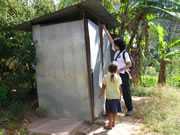Toilets & Latrines
The Need for Latrines and Toilets
Proper sanitation facilities (for example, toilets and latrines) promote health because they allow people to dispose of their waste appropriately. Throughout the developing world, many people do not have access to suitable sanitation facilities, resulting in improper waste disposal.
Absence of basic sanitation facilities can:
- Result in an unhealthy environment contaminated by human waste. Without proper sanitation facilities, waste from infected individuals can contaminate a community's land and water, increasing the risk of infection for other individuals. Proper waste disposal can slow the infection cycle of many disease-causing agents
- Contribute to the spread of many diseases/conditions that can cause widespread illness and death. Without proper sanitation facilities, people often have no choice but to live in and drink water from an environment contaminated with waste from infected individuals, thereby putting themselves at risk for future infection. Inadequate waste disposal drives the infection cycle of many agents that can be spread through contaminated soil, food, water, and insects such as flies.
Sanitation Facilities and Children’s Education
 According to the United Nations' Millennium Development Goals Report [PDF - 2.31 MB], one in five girls of primary-school age are not in school, compared to one in six boys. One factor accounting for this difference is the lack of sanitation facilities for girls reaching puberty. Girls are also more likely to be responsible for collecting water for their family, making it difficult for them to attend school during school hours 1, 2. The installation of toilets and latrines may enable school children, especially menstruating girls, to further their education by remaining in the school system.
According to the United Nations' Millennium Development Goals Report [PDF - 2.31 MB], one in five girls of primary-school age are not in school, compared to one in six boys. One factor accounting for this difference is the lack of sanitation facilities for girls reaching puberty. Girls are also more likely to be responsible for collecting water for their family, making it difficult for them to attend school during school hours 1, 2. The installation of toilets and latrines may enable school children, especially menstruating girls, to further their education by remaining in the school system.
For more information on school-based sanitation programs, read the report "Framework for Action on Water, Sanitation and Hygiene in Schools" from UNICEF/International Water and Sanitation Centre (IRC) at UNICEF's Water, Sanitation and Education.
Top of PageReference
- The United Nations. Millennium Development Goals Report 2007. Available at http://www.un.org/millenniumgoals/pdf/mdg2007.pdf [PDF - 2.31 mb].
- UNICEF and IRC. Water Sanitation and Hygiene Education for Schools: Roundtable Proceedings and Framework for Action. Available at http://esa.un.org/iys/docs/san_lib_docs/SSHE_OxfordRoundTable.pdf [PDF - 1.76 mb].
- Page last reviewed: December 17, 2015
- Page last updated: December 17, 2015
- Content source:


 ShareCompartir
ShareCompartir